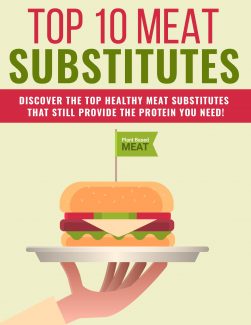 License Type: Private Label Rights
License Type: Private Label Rights  File Type: ZIP
File Type: ZIP
 SKU: 63807
SKU: 63807  Shipping: Online Download
Shipping: Online Download
Sample Content Preview
Introduction
Every year, more people are reconsidering the amount of meat they consume, choosing instead to implement healthy meat substitutes into their diets.
In fact, Persistence Market Research says the global plant-based protein industry may reach $16.3 billion by the year 2026, if it keeps growing at this rate.
There are a number of reasons for this:
With skyrocketing meat prices, and science that indicates that consuming a high level of meat may actually be unhealthy, more people are choosing a meat-free diet.
In addition, with the enormous meat “ranches” producing massive amounts of methane and depleting resources that could be used for human consumption – it’s just another reason that people are taking another look at meat substitutes for their dietary needs.
However, one thing to keep in mind if you are considering eliminating meat from your diet is that you must ensure you’re still receiving enough protein in your diet in order to stay healthy. Protein is every bit as important as vitamins, carbohydrates, and regular exercise when it comes to your overall health.
You see, protein helps build and repair body tissues such as bone, blood, skin, and muscles. Proteins also help increase overall muscle mass and strength. In addition, they help boost your metabolism so you can burn more fat.
A scientific study even showed that a high-protein diet helped lower blood pressure, “bad” cholesterol, and triglycerides. Protein also helps you feel fuller with less food, which is great for weight maintenance or loss.
To help you get started, we’ll take a look at some of the top meat substitutes throughout this special report.
Important Note Before We Begin:
When choosing a meatless product, carefully check the ingredients and the nutrition label. You want to make sure it isn’t loaded with unhealthy fats and salt, or are over-processed.
Look at the number of ingredients as well – the more ingredients there are, the more highly processed the product is. Also look for sodium and added sugar (fruit sugar is a natural form that’s better for you).
Not all products even contain enough protein to satisfy the daily recommended amount, so always read the labels. Some meat substitutes will contain added vitamins and nutrients that may be lacking in a typical vegetarian diet, like iron, zinc, and Vitamin B12.
In fact, only a few plant foods contain all nine of the essential amino acids needed. These are called complete proteins.
Soy, buckwheat, and quinoa are among the few plants that are complete proteins, so be sure to eat a variety of plant foods in order to get all of your essential amino acids.
Today, we’ll look at the top ten meat substitutes, as well as some nutritional information that you should know.
Let’s begin!
Meat Substitute #1: Tofu
Most meat substitutes are typically made of legumes like soy or peas, vegetables, and cereals. Those plants produce nearly as much protein as your body needs and can be combined to equal as much as you’d get from eating meat.
Tofu is the classic and most well-known meat substitute. It’s made from soybeans and has been used in Asia for centuries as an inexpensive, but healthy source of dietary protein.
It’s also low in calories and easily absorbs aromas and flavors from the spices and marinades you may use.
This makes it a versatile part of your diet. It’s meant to be eaten more like cheese – as a flavorful meal component all its own – though you can make some nice alt-meat products from it.
You make tofu by soaking soybeans, then mashing them with more water to make a puree. The next step is to filter the puree to separate the fibrous solids from the liquid part.
Heat the liquids to just below boiling points so it curdles, making the solid tofu in much the same way as cheese is made. You then press the tofu into slabs and cut it into whatever shape you wish – usually simple rectangles. The fibrous solid part of the puree, called okara, can be dehydrated and used as alt-meat chunks or mince.
Tofu comes in extra-firm, firm, soft, or silken. You can also press even more water from it before cooking for a crispier product.
Some recipes call for it to be patted dry before cooking. Make sure you follow your recipe to get the most flavor from your tofu.
Silken tofu is great for smoothies, while extra-firm can be fried or grilled like regular meat.
One cup of tofu usually contains about 188 calories, 20 grams of protein, 12 grams of fat, 868 milligrams of calcium, 13 milligrams of iron, and 0.7 grams of fiber.
One thing to look for is a non-GMO product or certified organic. According to a 2016 study, about 82 percent of the world’s soybean farms grow genetically modified organisms (GMOs).
Many consumers are leery of GMOs since we haven’t been eating them for very long and don’t know the long-term consequences of such products.
Soy is what’s called a complete protein, meaning it contains all nine needed amino acids. It’s usually fortified with Vitamin B12, which isn’t found in plant-based proteins.
Note that soy does contain natural phytoestrogens, so you shouldn’t eat it more than once or twice a week.
If you’re pregnant or have had a hormone-related cancer, talk to your doctor before eating tofu because the natural hormone might cause severe problems.
- License: Private Label Rights
- Category:Ebooks
- Tags:2021 Ebooks Private Label Rights








